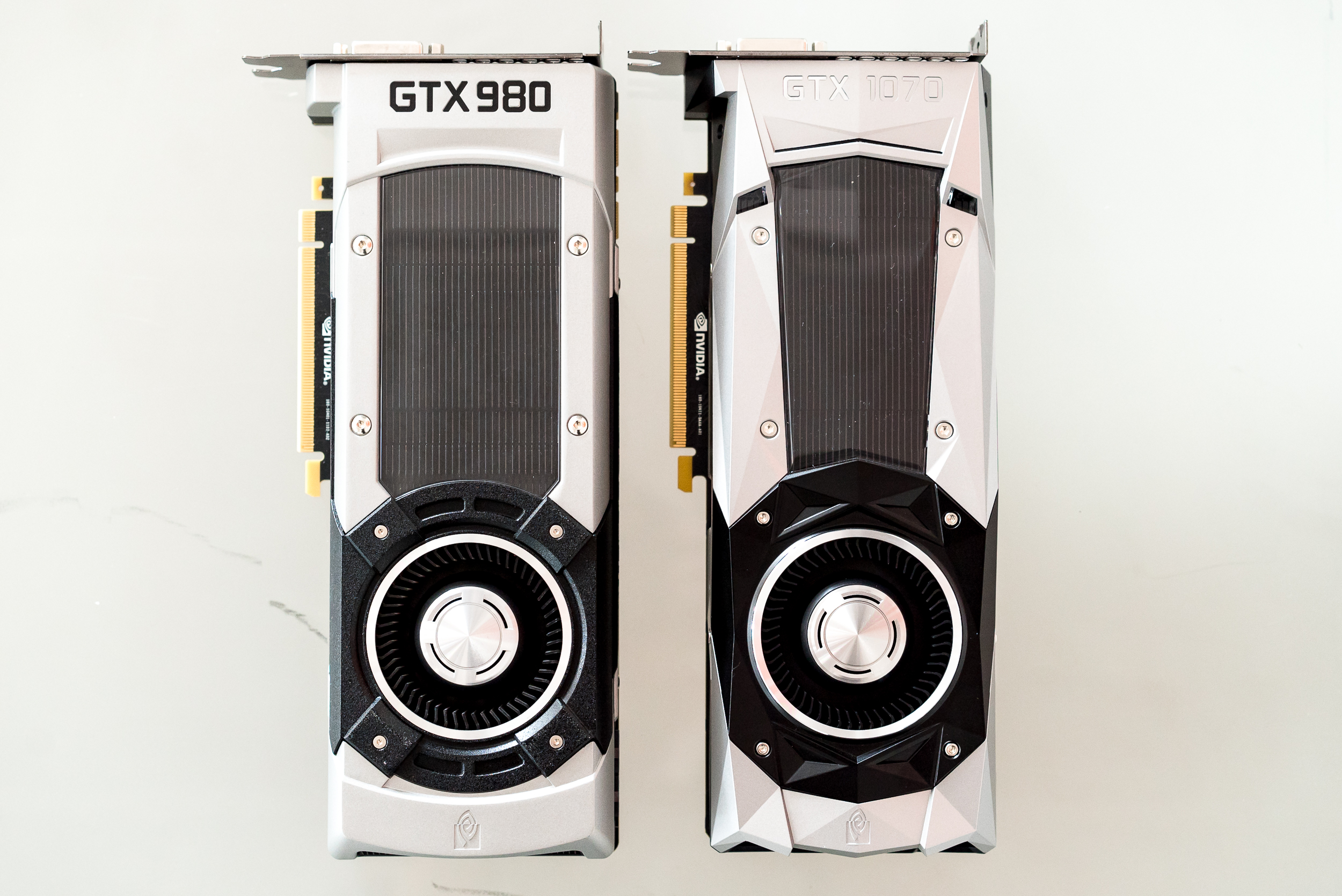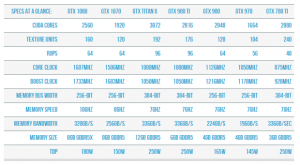In January, Nvidia’s GTX 970 became the most popular graphics card on Steam. This was a remarkable feat, considering the next most popular chip at the time, the HD Graphics 4000, isn’t really designed for gaming at all and is integrated into Intel CPUs. Today, the GTX 970 still commands a hefty five percent share of the Steam audience. Its successor, the GTX 1070—the second graphics card based on Nvidia’s latest Pascal architecture following the powerful but pricey GTX 1080—has some big shoes to fill.
And it does fill them—for the most part. As Nvidia promised, the GTX 1070 is indeed faster than both the GTX 980 Ti and the Titan X, and by some margin: as much as 12 percent in some tests. Just a couple of months ago GTX 980ti cards cost upwards of £500/$650, but the GTX 1070 costs just £399/$449 at the high end.
In its Founders Edition form (Nvidia’s new nomenclature for reference cards), the GTX 1070 is cool and quiet, too. The smaller, more efficient TSMC 16nm FinFET manufacturing process lets Nvidia ramp up performance to Titan-beating levels, while keeping the TDP down to a reasonable 150W.
From a price-performance standpoint, then, the GTX 1070 is undoubtedly better value than the GTX 1080. It offers around 80 percent of the performance for just 60 percent of the price.
But there are some issues. At £329/$379 for the OEM models (Asus, MSI, Gigabyte, etc.), the GTX 1070 is still a good £60/$50 more expensive than the GTX 970 launched at. That’s not to mention that those partner cards aren’t actually on the market yet. If you want a GTX 1070 when it’s released on June 10 (today!), you have to buy a Founders Edition, which costs a hefty £399/$449.
Still, even at that higher price point, there’s nothing in the same ballpark as the GTX 1070. Its closest competition, the similarly priced Fury Nano from AMD, only comes with 4GB of memory and is easily beaten by the GTX 1070, while the R9 Fury and R9 Fury X are both significantly more expensive. Nvidia may have moved the mythical graphics card sweet spot up a tad, but for now at least there’s simply no better option for the gamer that wants high-end performance without the silly high-end price tag.
GTX 1070: Founders Edition 2.0
Like the GTX 1080, the GTX 1070 is initially being released as a Founders Edition, which is essentially a reference card with a higher price tag and year-long availability. Yes, early adopters are getting stiffed once again, although judging by the sheer amount of GTX 1080 partner cards unveiled at this year’s Computex in Taiwan, GTX 1070 partner cards with custom coolers and factory overclocks should start to appear shortly after release.
Those that do opt for the Founders Edition get the same gorgeous, multifaceted shroud made out of aluminium as the GTX 1080, along with a blower-style design that exhausts hot air out of a PC case. There are some concessions to cost under the shroud, though, with the vapour chamber solution being replaced with a simpler aluminium heat sink with three embedded copper heat pipes. The much-touted five-phase power supply of the GTX 1080 gets a downgrade to a four-phase dual-FET design too.

None of these changes have a large effect on performance, especially given the GTX 1070’s lower 150W TDP. Overclocking ability (depending on the binning of your chip) is still impressive. Such a low TDP means there’s just a single 8-pin power PCIe power connector on top to feed the GTX 1070, while on the rear are three DisplayPort 1.4 ports, one HDMI 2.0b port with support for 4K60 10/12b HEVC decode, and one dual-link DVI port for those still rocking older monitors.
Under the hood is the same GP104 GPU as the GTX 1080, which is built on a small 314mm² 16nm TSMC die and the new Pascal architecture. I won’t get into the ins and outs of the architecture here—for that check out our GTX 1080 review—but essentially Pascal is a leaner version of Maxwell, with a focus on the FP32 performance that video games rely on. The key difference between the GTX 1080 and 1070 is that one of GP104’s graphics processing clusters (GPCs) has been disabled, shedding five streaming multiprocessors (SMs) in the process.
That leaves the GTX 1070 with 15 SMs, 1920 CUDA cores (vs. 2560) and 120 texture units (vs. 160), but the same number of ROPs, which should avoid the memory snafus of the GTX 970 (remember the 3.5GB kerfuffle?). It doesn’t feature the fancy GDDR5X memory of the GTX 1080, either, instead using standard GDDR5 on a 256-bit bus for 256GB/s of memory bandwidth. Clock speeds have been cut, too, down to a 1506MHz core clock and 1683MHz boost.

Up top there are two SLI interfaces that accommodate Nvidia’s new high-bandwidth bridges. Those bridges work at a higher 650MHz speed (versus 400MHz) by using the second SLI connector traditionally reserved for three- or four-way SLI configurations. Older bridges will also work, but at the slower speed.
Like the GTX 1080, Nvidia is only officially supporting two-way SLI with GTX 1070. Previously, Nvidia said that more cards could be used by downloading an unlock key from its website. It has now nixed that requirement, but in the process has revealed that three- or four-way SLI setups won’t be supported in games at all, and will only work in selected benchmarking applications like 3DMark. Two-way SLI has always made the most sense in terms of scaling—and given that GTX 1070 has only just been released, nobody will have bought more than two cards just yet—but it’s a poor show on Nvidia’s part not to be clear about its SLI plans from the start.
Finally, there’s GPU Boost 3.0, Fast Sync, HDR, VR Works Audio, Ansel, and preemption (an alternative approach to asynchronous compute), all of which are excellent additions, but aren’t unique to the GTX 1070. For more on those and the Pascal architecture, check out the GTX 1080 review.
GTX 1070 benchmarking setup
TEST SYSTEM SPECIFICATIONS
OS Windows 10
CPU Intel Core i7-5930K, 6-core @ 4.5GHz
RAM 32GB Corsair DDR4 @ 3,000MHz
HDD 512GB Samsung SM951 M.2 PCI-e 3.0 SSD, 500GB Samsung Evo SSD
MOTHERBOARD ASUS X99 Deluxe USB 3.1
POWER SUPPLY Corsair HX1200i
COOLING Corsair H110i GT liquid cooler
MONITOR Asus ROG Swift PG27AQ 4K
As with the GTX 1080, I’ve tested the GTX 1070 with a suite of games on the Ars Technica UK standard test rig, including three games that use DirectX 12. There’s still no reliable way to capture frame data for DX12 games without a dedicated hardware setup just yet, but for everything else there’s a 99th percentile score, which shows the minimum frame rate you can expect to see 99 percent of the time. This is a great way to highlight the comparative smoothness of games—the higher the gap between the average of the 99th percentile, the more jittery a game feels.
Each game was tested at 1080p, 1440p, and UHD (4K) resolutions at high or ultra settings, with a GTX 1070 at stock and overclocked speeds. The overclock was quick and dirty, but I still managed to ramp up the core clock to 2012MHz and the memory clock to 9000MHz while keeping the stock (read: reasonably quiet) fan speeds. It’s worth noting that I tested the GTX 1070 in a large case with lots of airflow. Some users have reported throttling with GTX 1080, but I didn’t see any of that behaviour during testing.
On the synthetics and science side there’s the standard 3DMark Firestrike benchmark (again, run across three resolutions), as well as LuxMark 3.0, CompuBench, and FAHBench (the official Folding@Home benchmark) to test compute performance.
